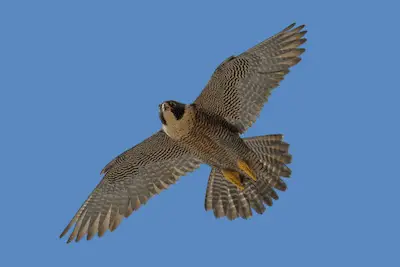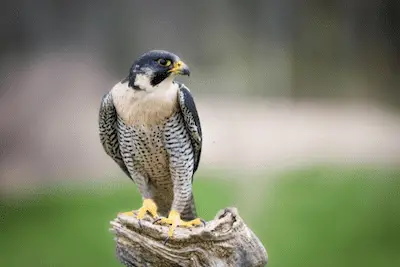Peregrine Falcon
(Falco peregrinus)
The Peregrine Falcon is one of the largest falcons in Europe, and is an impressive sight to behold for any naturalist or birding enthusiast.

Peregrine Falcons were almost driven to extinction during the last century, due to the widespread use of the pesticide DDT, but managed to recover after DDT was banned.
Fortunately, Peregrine Falcon populations have recently been on the rise in many parts of Europe, especially in areas where they have colonized cities.
Peregrine Falcons living in cities usually nest in tall buildings, such as churches or high rises, and feed on the plentiful supply of pigeons, and are a wonderful addition to the urban wildlife.
Peregrine Falcon facts
As one of the largest falcon species in Europe, the Peregrine Falcon is an unmistakable sight when seen soaring near cliffs or tall buildings, or when it stoops down like a missile to hunt its prey.
European Peregrine Falcon size
The Peregrine Falcon is a medium to large sized falcon, with a heavier build than most other European falcons.
- Wingspan: 90-105 cm
- Length: 37-45 cm
- Weight: 850-1,100 g (female), 580-730 g (male)
After the Gyrfalcon (Falco rusticulus) and the Saker Falcon (Falco cherrug), the Peregrine Falcon is the third largest European falcon species, though keep in mind that male Peregrine Falcons are significantly smaller than females.
Appearance
The Peregrine Falcon is a medium sized raptor with the pointed wings of a falcon, and a relatively short and compact tail. It also has a heavier build than other falcon species, and as a result is capable of taking larger prey (especially the large female).

Sexual dimorphism
Similar to other types of raptors in Europe, female Peregrines are significantly larger than males, and there is no overlap in size between the sexes. Otherwise, the two genders look very similar.
Lifespan
A maximum age of 18 years has been documented in the wild, as well as 25 years in captivity.
Scientific name and taxonomy
The scientific name of the Peregrine Falcon is Falco peregrinus. 19 subspecies are known worldwide, of which three are found in Europe. F. p. brookei occurs around the Mediterranean, F. p. calidus occurs in tundra, and the nominate species occurs in the rest of Europe.
The closest relative of the Peregrine Falcon in Europe is the Barbary Falcon (Falco pelegrinoides), which was previously thought to be a subspecies of the Peregrine Falcon, but is now classified as a separate species.
European Peregrine Falcon distribution
The Peregrine Falcon has an extremely wide global distribution. It is the most cosmopolitan of all raptor species, and inhabits all continents except the Antarctic. The Peregrine Falcon breeds in many European countries, except for Iceland, and some eastern European countries.
The Peregrine Falcon was driven to extinction in many areas of its European distribution due to relentless persecution, but has started recolonizing lost territory over the past couple of decades.
Peregrine Falcon habitat
The Peregrine Falcon lives in a very wide range of habitats. Basically, all it needs is a plentiful supply of birds to hunt, as well as suitable nesting sites. As a result of this, it is present in almost all habitats found in Europe, from coastal wetlands to high altitudes in mountainous regions.
Over the past few decades, Peregrine Falcons have increasingly started nesting in buildings and other manmade structures, such as quarries, which has allowed them to extend their breeding range.
European Peregrine Falcon population size
The European population of the Peregrine Falcon is estimated to be between 12,000 and 25,000 pairs by BirdLife International. The largest population is present in Spain (with up to 2,700 pairs), followed by France and the UK (each with up to 1,400 pairs). Up to 3,000 pairs are present in Turkey.
Peregrine Falcon behavior
The most common Peregrine Falcon behavior is soaring and gliding slowly at great height, while scanning the airspace below for any unsuspecting birds. When it spots suitable prey, it drops like a stone, and attempts to ram its prey in mid air, which often kills it instantly.
Sometimes pairs of Peregrine Falcons hunt together, which increases their success rate significantly.
Feeding and diet
The Peregrine Falcon feeds almost exclusively on birds, except for a small percentage of bats. It takes a very wide range of different species, with the exact species composition determined by the location.
Close to human settlements, feral pigeons are usually the main prey species, while in areas with coastal wetlands, wading birds tend to be the main prey species.
Breeding
Peregrine Falcons prefer to nest in cliffs or tall buildings, but there is also a small population in central Europe that nests in trees and uses the old nests made by crows and other raptor species.
In many parts of Europe, increasing numbers of Peregrine Falcons have colonized cities and towns, where they nest in church towers and other tall buildings, and prey on city pigeons that are usually available in large numbers.
The female lays 3-4 eggs, which are incubated for up to 35 days. After hatching, the young falcons stay in the nest for up to 42 days, and continue to be fed for up to five weeks after they leave the nest.
Peregrine Falcon migration
The Peregrine Falcon is a partial migratory bird, with the northernmost populations being almost completely migratory, while more southern populations are predominantly sedentary.
However, even in those latitudes where adult Peregrine Falcons are sedentary, juvenile birds regularly undergo nomadic movements over long distances during their first years of life.
Peregrine Falcon conservation status
After being driven close to extinction in most of Europe during the 1960s due to the use of the pesticide DDT, Peregrine Falcon populations have made a dramatic recovery in many areas of Europe, and some populations are steadily growing (probably due to the fact that they are adapting increasingly well to living in close proximity to humans),
Due to the overall stability of Peregrine Falcon populations, its conservation status is classified as of “Least Concern” by BirdLife International.
Threats
The biggest threats to the Peregrine Falcon are pesticides, due to the fact that it feeds most on birds, and is thus situated at the apex of the food chain. Because of this, it’s important to monitor Peregrine Falcon populations closely, as they will serve as a warning sign, should there be any issues with new types of pesticides used in agriculture.
Additional resources:
- Lanner Falcon conservation status
- Red-footed Falcon feeding and diet
- Eurasian Hobby conservation status
